Introduction
The rise of e-government has been one of the most striking developments on the Web. In just a few years, thousands of government agencies, legislators, and courts have established a Net presence. Today, all three branches of the federal government are online, and the portal FirstGov.gov claims to link to 47 million pages.6 In addition, all 50 states have government Web sites. Local governments are catching up. There are few places where any government official feels justified in not putting government information and services online.
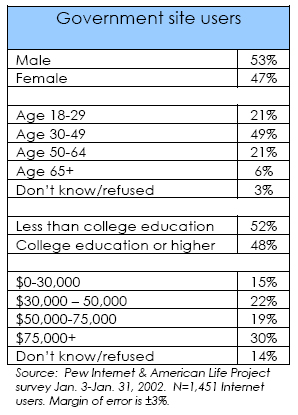
Our surveys show that one of the fastest growing activities online in recent years has been the use of government Web sites. Our January 2002 tracking survey shows that 58% of American Internet users, or 68 million adults, have visited at least one government Web site, and most have visited more than one. This makes the act of seeking government information and completing transactions with government agencies one of the most popular activities online. More Americans have visited government Web sites than have sought financial information online, made travel reservations, sent instant messages, or gotten sports scores online. The number of government Web users has grown substantially since our first survey in March 2000. At that point about 40 million American adults had gone to at least one government agency Web site.
Government Web site users are more likely than other Internet users to have college degrees (48% vs. 31%), and they live in households with somewhat higher incomes than the general Internet population. At the same time, those who use government Web sites are much like other Internet surfers in terms of gender and race.
Where government site users go; how often they visit
Twice as many government Web site users have visited federal agency sites as have visited the sites of their local government. Some 80% of those who use government Web sites have visited federal agency Web sites and 76% have visited state sites. But only 41% have visited their municipal or county sites. One reason for the difference may be the lack of familiarity with local sites. While a study from the University of Maryland in 2000 found that more than 80% of local governments have a Web site,7 we found in a survey last year that only half of Internet users were able to tell us whether their local government had a Web site at all.
Asked which sites they visited most frequently, 34% of these users said it was federal Web sites, 33% said it was state sites, and 11% said it was local sites. The rest either said they frequented all types of sites equally or didn’t know what sites they visited most.
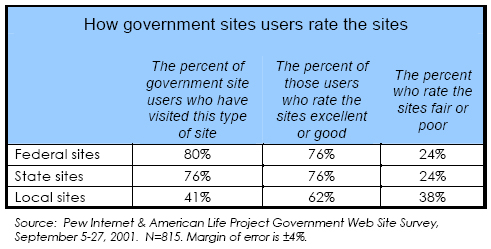
Men are more likely than women to say federal sites are the sites they frequent most often. Federal Web sites are particularly popular among those who have at least some college education (over 80% compared to 69% of high school graduates). In contrast, women are more likely than men to cite state and local sites as their favorite. State government Web sites are equally popular among those with and without college educations.
Blacks in particular are more likely than other groups to favor the content available at their local government Web sites. Some 63% of black Internet users have sought out a local government site, compared to 40% of whites. In addition, 30% of black users cite local government sites as the type they visit most frequently, compared to 10% of whites.
Among Internet users who say they have visited government Web sites, 6% say they visit such sites every day, 20% say they visit several times a week, 41% say they visit several times a month, and 32% say they visit just a few times a year. Among those who claim a “favorite” government Web site, the visits are even more frequent, up to several times a week. In their most recent search for government information online, 61% of government Web site users did their browsing from home.
The information they seek
The most popular activities at government Web sites relate to the search for information. Understandably, people flock to the Internet to track down material that might otherwise take hours to obtain by phone or through personal visits to government agency offices.
Internet users research a variety of items on government Web sites, including material about what agencies do, the facts that are contained in government databases and documents, information related to civic issues, and insights into the business climate or opportunities in various communities.
The top three types of information sought address recreation, work, and personal concerns. Tourism and recreation goals top the list, with 77% of government site users seeking it out. This is perhaps due in part to the home page promotions that many states and localities employ. For instance, the Maine Web site allows visitors to reserve campsites online.8 Vacation planning is followed by doing research for work or school (70%) and searching or information about the services offered by particular agencies (63%).
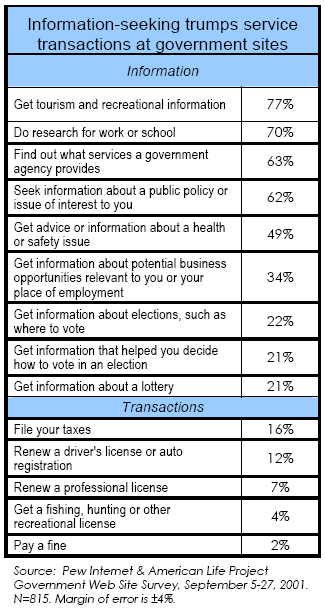
There are no strong demographic differences among those who use government sites for those top activities. Women are somewhat more likely than men to do work-related government surfing (73% to 66%). Those over the age of 65, surprisingly, are less likely than other age groups to use the Internet to learn about government benefits (34% compared to over 60% for all other age groups). But the most popular activities, on the whole, are equally popular among all groups.
By contrast, job seeking at government sites is the most highly segmented task. About a quarter of government site users (24%) have looked for government jobs online. Blacks are more likely than whites, by a margin of 58% to 21%, to look for job listings on government sites. This discrepancy can be explained in part by fact that blacks online in this particular population tend to be younger than whites,9 and young people were more likely than older to be seeking government jobs. Some 37% of government site users aged 18-29 had sought government job postings, while only 26% of those aged 30-49 and 14% of those aged 50-64 have done so. This probably tracks closely with overall trends in job seeking. Younger Americans are more likely to be active in the job market than middle-aged and older Americans.
Perhaps in keeping with the youth of job seekers, incomes among those looking for government jobs are also lower: More than a third (35%) of government Web site users in households with under $35,000 of income have sought out government employment, compared with 20% of those in households earning more than $50,000. Finally, among government site users, government jobs tend to appeal to those who already work for the public sector. Government employees are more likely than those who do not work for the government to look up government jobs, by a margin of 34% to 21%
Frequent surfers have the broadest experience of using information and features at government Web sites. They have performed and average of seven of the tasks we asked about, compared to five or six for less frequent government site users. Frequent surfing is also the strongest predictor of whether an individual has sought any of the given types of information. Online longevity is also associated with each of these, though to a lesser extent.
Getting involved
There is concern among academics, activists, and even some elected officials that government Web sites might focus too much on providing services, and not enough on facilitating Americans’ civic involvement. This service orientation, they argue, treats citizens as consumers rather than owners of government, and thus inhibits public engagement with the nation’s political life.
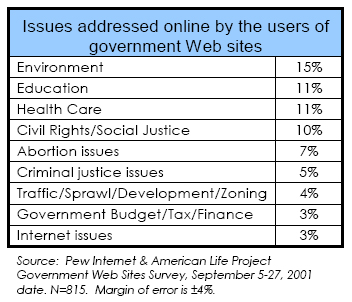
Our survey suggests that while government site users are certainly taking advantage of all the services and information made available on government sites, a portion are also very active in using the Internet to monitor public affairs. Close to two-thirds of them (62%) have sought out information on public policy issues via government sites. About one in three (34%) has taken the extra step of contacting an official through a site and one in five (19%) has used the Internet as part of a concerted lobbying campaign. That activity translates into impressive numbers: It means 42 million Americans have used government Web sites to research public policy issues; 23 million Americans have used the Internet to send comments to public officials about policy choices; and 13 million have participated in online lobbying campaigns. Asked about the issues they had lobbied for, government site users cited environmental, educational, and health issues most often. In addition, 21% of government site users have gathered information from such sites to help them decide how to vote in an election. That translates into more than 14 million people.
Are government Web site users more likely than other people to be politically engaged? We do not have enough data on the political activities of this group to draw direct comparisons with the rest of the population, but we can provide some perspective. According to the Pew Research Center for The People & The Press, 41% of American adults have ever contacted an elected official. Of course, anyone who has emailed an elected official is likely to have done so only in the past few years, and cannot be lumped together with people who may have written a letter 10 or 15 years ago. The same Pew Research Center survey found that 19% of adults have contacted an elected official within the past year. Looking at both numbers, it appears that government Web site users compare favorably with the general population for civic engagement.10
Some final observations about online activism: First, although it is often assumed that activism online is an activity for young Americans, our survey shows that those ages 18-29 are the least likely to have used the Internet in overtly political or activist ways. Second, there is no relationship between trust and using the Internet to research public issues or to contact officials. People who are wary of government are just as likely as those who trust it to use the Internet to try to influence the direction of policy or monitor issues.
The impact on citizen-government interactions
We asked government site users to what extent their use of government sites had improved their relationship with their public agencies. Overall, 60% of government Web site users say such sites had improved their interactions with at least one level of government. Some 49% said the Internet had improved the way they interact with the federal government, 45% said it had improved the way they interact with state government and 30% said it had improved the way they interacted with local government.
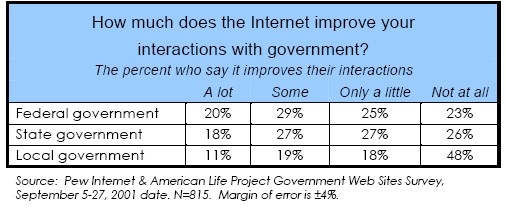
Internet veterans were more likely that those with less experience to express appreciation for the Internet’s role. Assessment of the benefits of government sites was also affected by how frequently visitors used them, and how much trust they have in government.

Assessing site quality
Those who use government Web sites are more impressed with federal sites than state or local sites. Seventy-six percent of government users rate the quality of federal government sites as “good” or “excellent,” compared with 61% for local government sites.
Trust in government is strongly related to the perceived quality of government Web sites: fully 86% of high trusters, some 80% of medium trusters, and just 62% of low trusters rate federal and state Web sites as “good” or “excellent.” Local government Web sites earn fewer accolades, but still do better among those who trust government. Some 72% of high, 64% of medium, and 49% of low trusters give local government sites good or excellent ratings.
Finally, those who successfully accomplished what they set out to do at government sites were more likely to give them high marks. And frequent government site users were more likely than occasional surfers to rate the sites highly.
How often they find what they want
Respondents say government agencies have a spotty record about making it easy to find the information the public wants. A majority of respondents believe that it is “fairly” or “very” easy to find information on federal sites (68%) or state sites (69%). However, only 46% say the same about local government. As noted above, 80% of government visitors said they were able to accomplish what they wanted to at their last visit to a government Web site. That is fairly similar to the record that other groups report about other kinds of online searches. For instance, it is close to the figure that is reported by those seeking health information and those seeking religious information online.
However, it also means that 20% of government site users were frustrated in their attempt to find information in their most recent searching episode. We do not know if those who were frustrated were simply faced with sites that lacked the content they needed11, or if they did not know how to navigate through the pages. If navigation was the main problem, we would expect that the most frequent surfers – those most familiar with government sites – would have higher success rates in finding what they want online. In fact, they are no more successful than less active surfers in this regard.
Education and trust in government were associated with successful searching. College graduates said they found what they were looking for most of the time (63% v. 53% for non-college grads).


